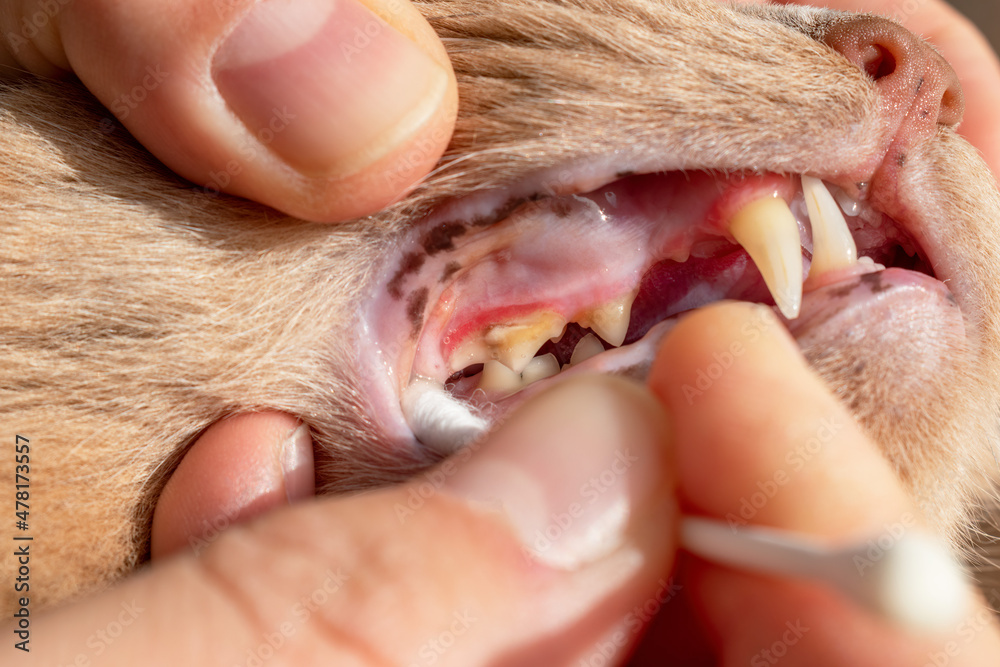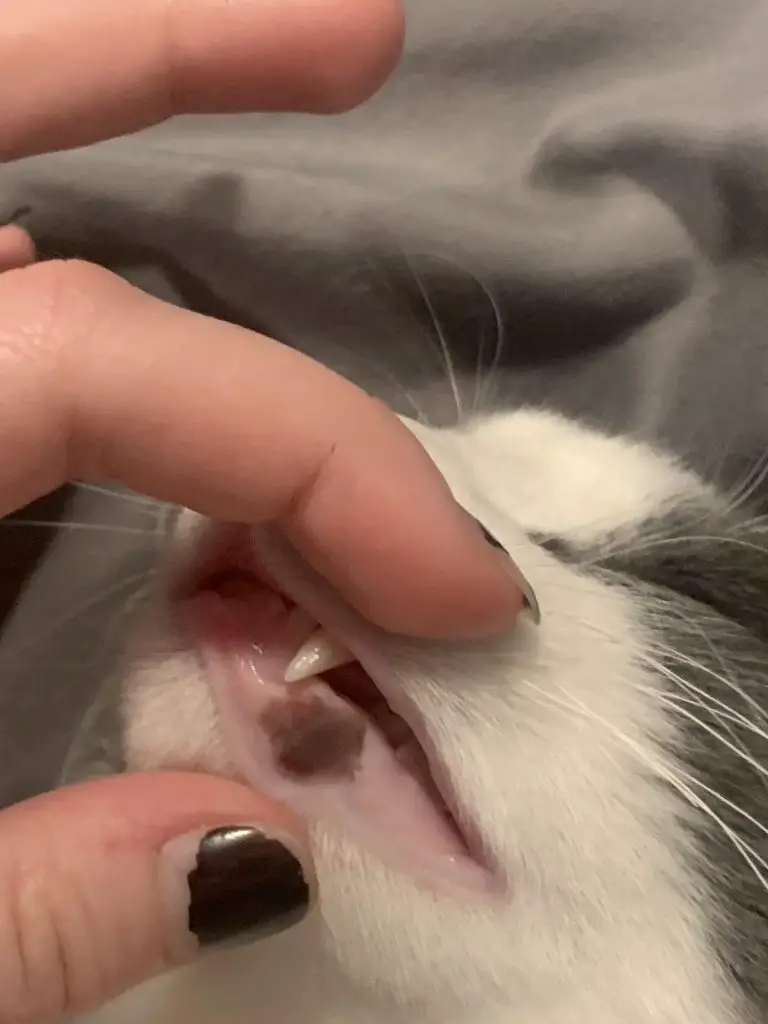The brown coloration of your cat’s gums could be indicative of a dental issue or gum disease, requiring prompt veterinary attention. When your cat’s gums turn brown, it could be a sign of dental problems or gum disease.
Taking your cat to the vet is important to receive proper diagnosis and treatment. Dental issues in cats can range from plaque and tartar buildup to periodontal disease, and brown gums may indicate infection or inflammation. Prompt veterinary attention will help to identify the underlying cause and prevent further complications.
Additionally, maintaining good dental hygiene at home, such as regular brushing, can help prevent the development of gum disease and other dental problems in cats.
Understanding Brown Gums In Cats
Brown gums in cats can be a cause for concern, as they may indicate an underlying health issue. There are several potential causes for this discoloration, including dental problems, gum disease, and oral infections. Additionally, certain systemic diseases and medications can also contribute to brown gums in cats.
Causes And Treatments
The brown color in the gums could be a sign of dental tartar or plaque buildup. Professional dental cleanings by a veterinarian can effectively remove these substances, leading to healthier gums. In some cases, brown gums may be a result of periodontal disease, which may require more extensive treatment, such as tooth extraction or gum surgery.
Infections, such as stomatitis or gingivitis, could also be responsible for brown gums. Treating the underlying infection typically involves antibiotics or antifungal medications, along with dental care to address any contributing factors.
Prevention And Home Care
Regular dental care is crucial in preventing brown gums in cats. Brushing their teeth using cat-specific toothpaste can help remove plaque and tartar buildup. Feeding a balanced diet and providing appropriate chew toys can also contribute to dental health. It is important to monitor your cat’s gum color and seek veterinary advice if you notice any changes, including persistent brown discoloration.
Remember, maintaining good oral hygiene is key to ensuring your cat’s overall health and well-being!
Causes Of Brown Gums In Cats
Causes of brown gums in cats include dental disease, gum infection, poor oral hygiene, nutritional deficiency, and tobacco exposure.
Dental disease refers to various conditions that affect the teeth and gums, such as periodontal disease, which is caused by a buildup of plaque and tartar. This can lead to inflammation and discoloration of the gums.
Gum infection, or gingivitis, is another common cause of brown gums in cats. It occurs when bacteria accumulate along the gumline, leading to irritation and discoloration.
Poor oral hygiene, including a lack of regular brushing and dental care, can also contribute to the development of brown gums. Without proper cleaning, food particles and bacteria can accumulate, leading to gum discoloration.
Nutritional deficiency can also affect the health of a cat’s gums. A lack of certain vitamins and minerals, such as vitamin C and zinc, can result in gum discoloration and other oral health problems.
Tobacco exposure, either through secondhand smoke or chewing tobacco, can have detrimental effects on a cat’s oral health, including brown discoloration of the gums.
Dental Disease And Brown Gums
When cats have brown gums, it is often indicative of dental disease. One common cause is the buildup of plaque and tartar on their teeth. Plaque is a sticky film that forms on the teeth when bacteria combine with saliva. If not removed through regular brushing or dental cleanings, plaque hardens into tartar, which can lead to gum inflammation and brown discoloration.
Dental disease can progress to periodontal disease, which involves the breakdown of the tissues surrounding the teeth. This can cause gums to appear brown or even black in severe cases. Another common form of dental disease is gingivitis, characterized by red, swollen gums. Additionally, tooth decay can contribute to brown gums, as bacteria can eat away at the tooth enamel and cause discoloration.
To prevent dental disease and brown gums, it’s crucial to establish a regular dental care routine for your cat. This includes brushing their teeth, providing dental-friendly toys or treats, and scheduling regular veterinary dental check-ups and cleanings. Taking proactive steps to maintain your cat’s oral health can help keep their gums healthy and their teeth free from discoloration.
Gum Infection And Brown Gums
Brown gums in cats can be a sign of gum infection, specifically a condition called periodontitis. Periodontitis is a severe form of gum disease that affects the tissues surrounding the teeth, leading to inflammation, infection, and ultimately, brownish discoloration of the gums.
Feline stomatitis is another potential cause of brown gums in cats. This condition involves severe inflammation and ulceration of the gums, often resulting in brownish or reddish discoloration.
Oral ulcers can also contribute to the development of brown gums in cats. These ulcers can be caused by various factors, including viral or bacterial infections, immune system disorders, or even trauma to the mouth.
Certain immune system diseases can lead to brown gums in cats. Conditions such as feline immunodeficiency virus (FIV) or feline leukemia virus (FeLV) can weaken the immune system, making cats more susceptible to infections and gum diseases that can cause gum discoloration.
Poor Oral Hygiene And Brown Gums
There can be several reasons why your cat’s gums may appear brown in color. One common cause is poor oral hygiene due to a lack of regular brushing. Cats require proper dental care just like humans do, and neglecting their oral health can lead to various dental issues, including brown gums.
When cats do not have a regular dental care routine, plaque and tartar buildup can occur on their teeth. This can eventually result in gum inflammation and discoloration. Inadequate dental care can also lead to periodontal disease, which can cause brown pigmentation in the gums.
To maintain your cat’s oral health, it is essential to establish a dental care routine that includes regular brushing, preferably with a cat-specific toothbrush and toothpaste. Additionally, providing dental treats or incorporating a dental diet can help reduce plaque and tartar buildup.
If you notice your cat’s gums turning brown, it is important to consult with a veterinarian. They can evaluate your cat’s oral health and provide appropriate treatment or recommendations to improve their dental hygiene.

Credit: stock.adobe.com
Nutritional Deficiency And Brown Gums
One possible reason for your cat’s brown gums could be a vitamin deficiency. Cats require a balanced diet that includes essential vitamins, such as vitamin C and vitamin K. A lack of these vitamins can lead to gum problems, including discoloration. If your cat’s gums appear brown, it may be a sign that they are not getting enough of these vital nutrients.
A mineral deficiency can also contribute to brown gums in cats. Minerals like iron and copper are important for maintaining healthy gums. A lack of these minerals can lead to gum discoloration and other oral health issues. It’s important to ensure that your cat’s diet includes an appropriate balance of minerals to prevent brown gums.
Lastly, malnutrition can be a factor in brown gums. If your cat is not receiving a well-rounded diet with the necessary nutrients, it can lead to various health problems, including oral issues. Brown gums may be an indication that your cat is not getting the proper nutrition it needs to maintain healthy oral tissues.
Tobacco Exposure And Brown Gums
Exposure to tobacco can cause a variety of health issues for cats, including brown gums. Secondhand smoke can have detrimental effects on a cat’s oral health, potentially leading to gum discoloration. Additionally, if a cat chews tobacco or comes into direct contact with it, this can further contribute to the browning of the gums. The nicotine found in tobacco products can also poison cats, causing them to experience a range of symptoms, such as brown gums. It is crucial for cat owners to be aware of the dangers of tobacco exposure and take necessary steps to protect their feline companions from it. Keeping cats away from areas where smoking occurs and avoiding the use of tobacco products near them can help prevent these issues and promote healthier gums for your cat.
Treatment Options For Brown Gums
Having brown gums in cats can be a cause for concern and may indicate an underlying dental problem. It is important to seek veterinary examination and diagnosis to determine the cause and provide appropriate treatment. Treatment options for brown gums may include:
| Veterinary examination and diagnosis |
| Professional dental cleaning |
| Antibiotics and medication |
| Dental surgery |
A veterinary examination and diagnosis is necessary to identify the underlying cause of brown gums and rule out any other potential oral health issues. Professional dental cleaning can remove plaque and tartar buildup, improving the overall oral hygiene of the cat. Antibiotics and medication may be prescribed to address any infection or inflammation present. In more severe cases, dental surgery might be required to address conditions like periodontal disease or tooth extraction.
Prevention And Home Care For Brown Gums
Avoiding brown gums in cats requires regular brushing and dental cleanings, appropriate diet and nutrition, avoiding tobacco exposure, and providing chew toys and treats. Regular vet check-ups and dental exams are also crucial for prevention and home care. Proper dental hygiene is essential to prevent gum disease and discoloration. Brushing your cat’s teeth regularly can help remove plaque and maintain healthy gums. Additionally, dental cleanings by a professional veterinarian are recommended to thoroughly clean and assess your cat’s oral health. Feeding your cat a high-quality diet that promotes dental health can also contribute to preventing brown gums. Avoiding tobacco exposure is important as it can lead to gum disease and oral health problems. Providing chew toys and treats can help keep your cat’s teeth and gums strong and clean. Finally, regular vet check-ups and dental exams will ensure any underlying dental issues are identified and treated promptly.
Conclusion
To sum up, understanding the reasons behind your cat’s brown gums is crucial for their overall health. Several factors, such as dental issues, gingivitis, or systemic diseases, can contribute to this discoloration. Regular dental check-ups, proper oral hygiene, and a balanced diet are essential for preventing gum problems and maintaining your cat’s oral health.
If you notice any concerning changes in your cat’s gums, don’t hesitate to consult a veterinarian for a thorough evaluation and appropriate treatment. Remember, healthy gums mean a healthier and happier feline companion.


